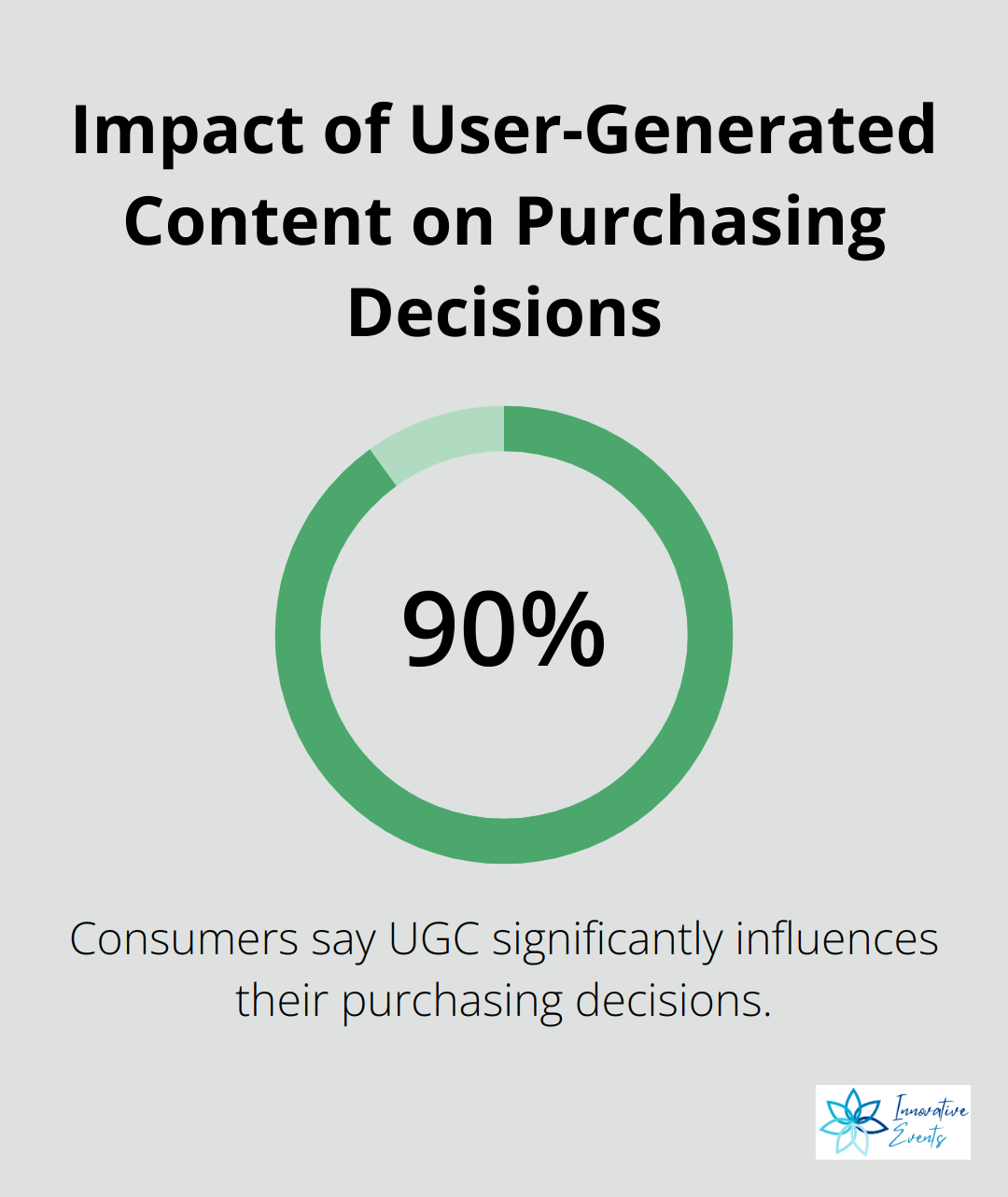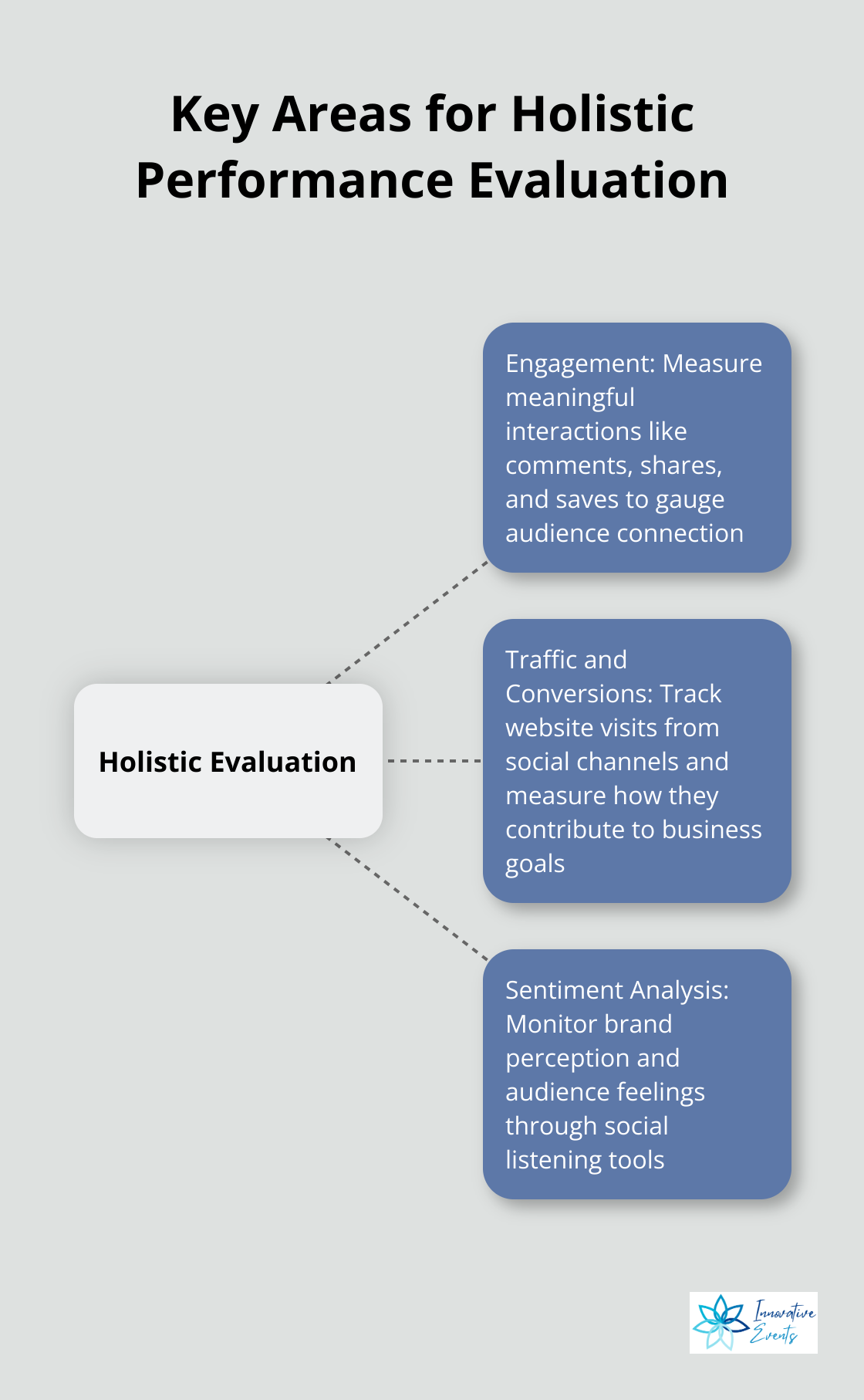At Innovative Events, we’ve seen firsthand how content and social media marketing work together to create a powerful impact.
This dynamic duo amplifies brand reach, builds trust, and delivers consistent messaging across multiple channels.
In this post, we’ll explore strategies for effective content distribution on social platforms and share key metrics to measure your success.
How Content and Social Media Marketing Supercharge Each Other
Expanding Your Content’s Reach
Social media platforms act as content distribution powerhouses. Sharing blog posts, videos, and infographics on social channels increases their visibility exponentially. Hootsuite’s survey reveals that in 2025, brands are expected to spend more on influencer marketing than on digital ads, indicating a shift in trust and impact. This alignment with content marketing goals makes social media an ideal vehicle for dissemination.

To maximize reach, content must be tailored for each platform. This approach includes:
- Creating eye-catching visuals for Instagram
- Crafting concise, punchy messages for X
- Developing in-depth articles for LinkedIn
This platform-specific strategy ensures content resonates with each audience, which drives engagement and shares.
Establishing Authority Through Consistency
Consistent posting across social channels reinforces a brand’s expertise and builds trust. Sprout Social’s report shows that 90% of consumers rely on social media to keep up with trends and cultural moments. Regular sharing of valuable content positions a brand as a go-to resource in its industry.
User-generated content further boosts credibility. Brands should encourage customers to share their experiences and showcase this content on social profiles. This approach provides social proof and fosters a sense of community around the brand.
Crafting a Cohesive Brand Narrative
A content strategy should seamlessly integrate with social media presence to create a unified brand story. This consistency reinforces the message and makes the brand more memorable.
To achieve cohesion, brands should develop a content calendar that aligns blog posts, social media updates, and other marketing materials. This ensures that the audience receives a consistent message across all touchpoints, which strengthens brand recall and loyalty.
The synergy between content and social media marketing creates a powerful ecosystem that amplifies a brand’s voice, builds trust, and drives meaningful engagement with the target audience. This powerful combination sets the stage for effective content distribution strategies on social media platforms (which we’ll explore in the next section).
How to Maximize Your Content’s Impact on Social Media
At Innovative Events, we have refined our approach to content distribution on social media platforms. Here’s how you can make your content work harder and smarter across various channels.
Platform-Specific Content Optimization
Each social media platform has its own unique ecosystem. To succeed, you need to tailor your content accordingly:
Instagram thrives on visuals. Transform your long-form content into eye-catching infographics or create short video summaries. Use Instagram Stories to share behind-the-scenes content or tease upcoming blog posts.
On X, brevity is key. Distill your main points into concise, impactful tweets. Use thread features for longer narratives, ensuring each tweet can stand alone while contributing to the overall message.
LinkedIn favors professional, in-depth content. Share full articles or create native posts that dive deep into industry insights. Engage with comments to foster meaningful discussions.
Facebook allows for versatility. Mix video content, long-form posts, and interactive elements like polls to keep your audience engaged. Utilize Facebook Groups to create niche communities around your content topics.
Harnessing the Power of User-Generated Content
User-generated content (UGC) is a goldmine for authenticity and engagement. According to Stackla, 90% of consumers say that UGC significantly influences their purchasing decisions. Here’s how to leverage it:

Run contests or challenges that encourage users to create content related to your brand or products. Share the best submissions on your social profiles and website.
Implement a branded hashtag and regularly feature posts that use it. This not only provides fresh content but also builds a community around your brand.
Reach out to customers who’ve shared positive experiences and ask permission to repurpose their content. This shows you value their input and provides social proof for potential customers.
Strategic Use of Paid Social Advertising
While organic reach is valuable, paid advertising can significantly boost your content’s visibility. Here’s how to make the most of your ad spend:
Use retargeting ads to re-engage users who’ve interacted with your content but haven’t converted. Show them related articles or offers to move them further down the funnel.
Leverage lookalike audiences to expand your reach. These audiences share characteristics with your existing customers, increasing the likelihood of engagement with your content.
A/B test different ad formats and copy to optimize performance. What works for one piece of content may not work for another, so continuous testing is essential.
Utilize platform-specific ad features. For example, Facebook’s Instant Experience ads allow you to create immersive, full-screen experiences that showcase your content in a unique way.
Measuring and Analyzing Performance
To truly maximize your content’s impact, you must measure and analyze its performance across social media platforms. This data-driven approach (which we’ll explore in more depth in the next section) will help you refine your strategies and achieve better results over time.
How to Measure Content and Social Media Success
Engagement: Beyond Surface-Level Metrics
At Innovative Events, we understand the importance of measuring content and social media impact. Engagement rates reveal how your content resonates with your audience. Focus on meaningful interactions, not just likes. Comments, shares, and saves indicate deeper audience connections.
Track these metrics across platforms and content types. Use analytics tools to aggregate engagement data. Identify patterns in high-performing content and replicate those elements in future posts.
Traffic and Conversions: Action-Oriented Results
Website traffic from social channels demonstrates how effectively you drive your audience to take action. Focus on quality, not just raw traffic numbers.
Set up UTM parameters for each social post to track which content drives the most valuable traffic. Analyze metrics like time on site, pages per session, and bounce rate to assess social traffic quality.
Track conversions as the most critical metric. Measure how social traffic contributes to your bottom line (whether it’s newsletter sign-ups, product purchases, or event registrations). Set up goal tracking to attribute conversions to specific social campaigns.
Sentiment Analysis: The Pulse of Your Audience
Brand sentiment reveals how people feel about your content and brand. Monitor conversations about your brand across social platforms using social listening tools.
Examine the context of mentions, not just volume. Are people excited about your latest product launch? Frustrated with a recent change? This qualitative data helps you understand the “why” behind your metrics.
Analyze sentiment trends over time. If you notice a shift, investigate the cause and adjust your strategy accordingly.
Holistic Performance Evaluation
These metrics are interconnected. High engagement loses significance if it doesn’t lead to conversions. Positive sentiment should translate to tangible business results.
Focus on these key areas – engagement, traffic/conversions, and sentiment – to gain a comprehensive view of your content and social media performance. Use these insights to refine your approach continuously, creating content that resonates with your audience and drives meaningful results for your business.

Final Thoughts
Content and social media marketing form a powerful alliance that transforms a brand’s digital presence. This synergy amplifies reach, builds trust, and delivers consistent messaging across multiple channels. The integration of well-crafted content with strategic social media distribution creates a robust ecosystem for audience engagement.
AI-driven content creation, short-form video, and social commerce will shape the future of digital marketing. Businesses must adopt a holistic approach to harness this powerful combination. This includes aligning content strategy with social media goals, tailoring content for each platform, and leveraging user-generated content to build authenticity.
Innovative Events understands the importance of a comprehensive approach to health and performance. We help busy executives achieve optimal well-being through our personalized, integrative lifestyle program. The time to act is now. Embrace the synergy between content and social media marketing to elevate your brand’s digital presence and drive meaningful business outcomes.

